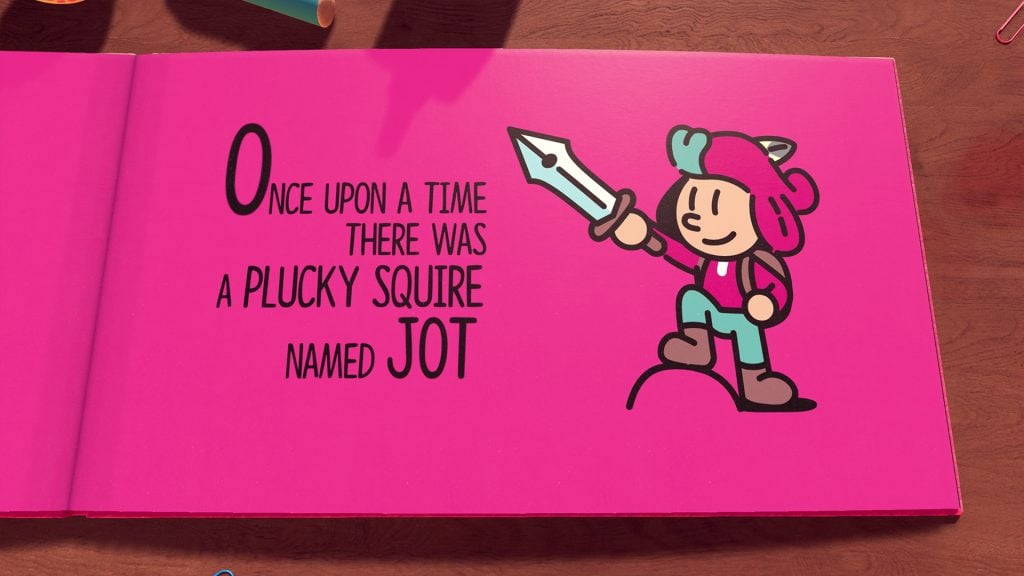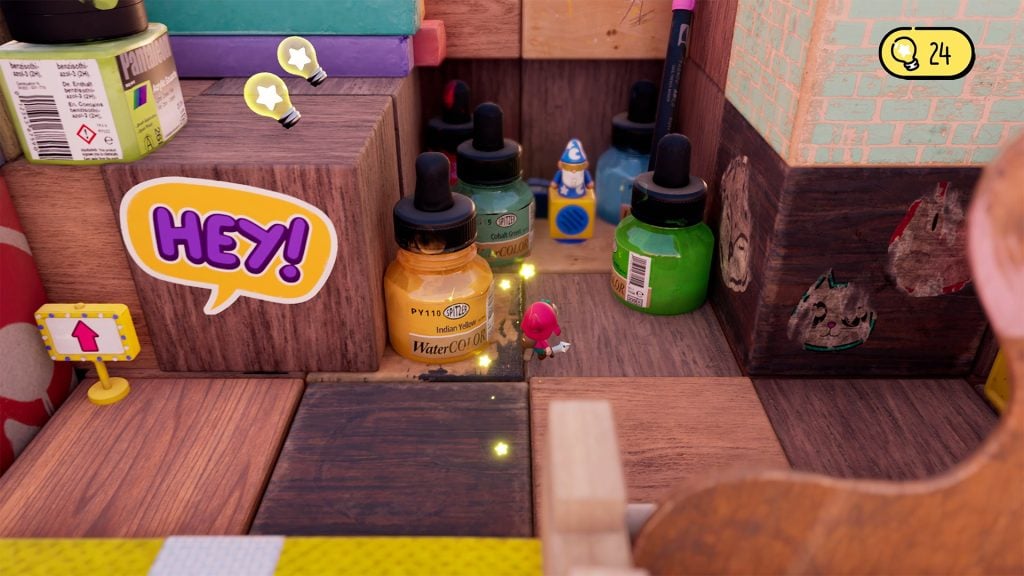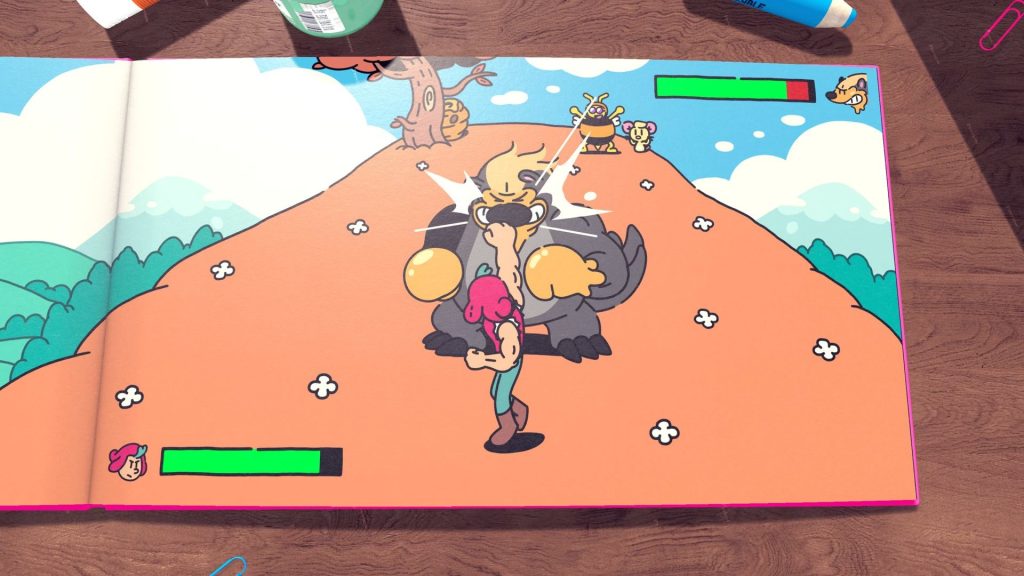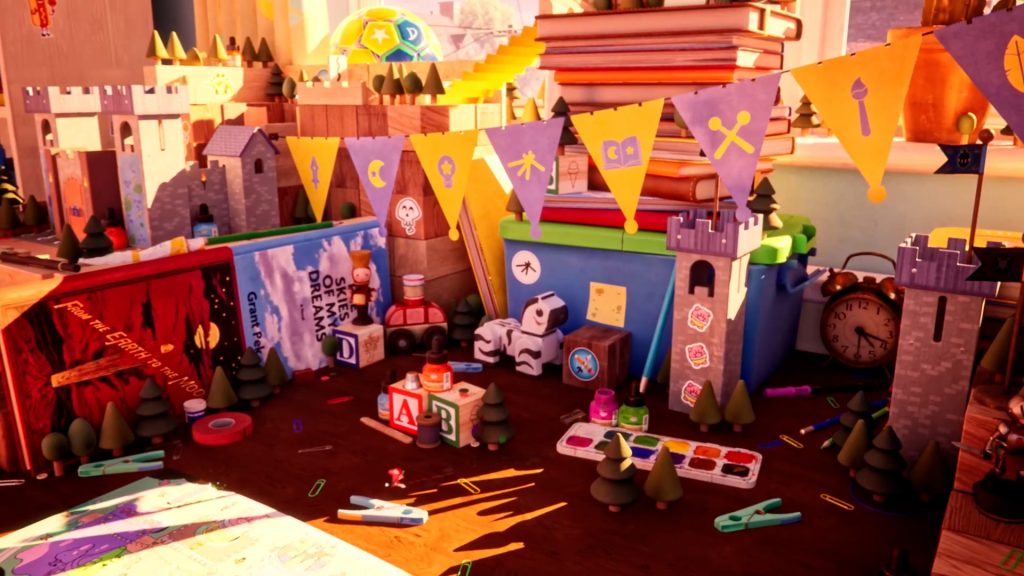Disclaimer: This review was based on the PC version of The Plucky Squire.
As time goes on, I find myself appreciating just how wonderful a great piece of art can be. While “great” is a subjective term when it comes to art, calling the piece in question high-quality is factual. Video games are art. Their mere existence requires the work of brilliant minds and steady hands. In the face of rampant layoffs in the gaming industry, I feel it’s important to remind each other that it takes a human touch to bring us these great experiences—experiences that stick with us beyond the game itself.
The Plucky Squire is one of these experiences. What All Possible Futures and Devolver Digital have done with childlike whimsy and an inspired sense of scope is reminiscent of Pixar’s best films. It just so happens that this is similarly existential. Instead of toys or cars coming to life, what if storybooks and their characters were aware of the outside world and the role they play in it?
This all might seem incredibly on the nose to you, a jaded adult who has experienced all kinds of media, much like myself. Believe me when I say The Plucky Squire nails its concept. The game takes one growing child’s bedroom and makes it feel like a universe with just some building blocks, stickers, misplaced toys, and realistic lighting. This universe changes from day to night, but the book the story takes place in and around stays the same. Its ending has been written, and the story will see its heroic conclusion.
Until one day, when that all changes.
The Plucky Squire is the name of the book in a child named Sam’s bedroom. As we come to find out, he has been influenced by the book. Memorabilia of Jot, the namesake heroic swordsman, can be spotted all around Sam’s room, even extending to birthday cards he’s received from family members. He has read through the book from beginning to end. The evil sorcerer Humgrump plays the villain, and in a scene that felt right out of Megamind, he exclaims that he’s had enough of the hero always winning. Why must the bad guy always lose? He’s onto the fixed setup of the plot.

It’s with this setup where Jot and his friends—the metalhead troll Thrash and pastel witch Violet—learn that Humgrump intends to change the story to a villain’s rise and a hero’s end. This could mean curtains for Jot and his literary world. Sam may not want to read the book anymore and shelve it. If a book is deemed bad or gloomy, it gets shelved, which is essentially a death toll for unwanted books. It’s all very Truman Show meets Toy Story in a way. To carry out this task, Humgrump throws Jot out of his own book and into Sam’s bedroom in the real world. It’s here where my jaw dropped. The Plucky Squire utilizes a colorful, squiggly-outlined storybook look, with its pages shimmering, flipping, and an omnipotent narrator’s words appearing as the tale unfolds. However, when thrust into the real world, Jot, with his bold outlines and dotted eyes, becomes a fully 3D character, and the visual style transforms effortlessly into real open space.
The gameplay styles also transform to reflect this change. When inside the book, The Plucky Squire plays like an old Legend of Zelda title, with the familiar overhead view and sword combat, as well as block and key puzzles. When you are popped out of the book, The Plucky Squire plays like a traditional 3D platformer. It’s here where I felt the visuals and world design reminded me of 2022’s underrated indie gem, Tinykin. Even more exciting still is the third gameplay loop, which centers around the idea of moving objects from the real world into the book or vice versa. With the help of the friendly wizard/aspiring DJ Moonbeard and the sentient world-hopping snail Page, you can even flip the pages of the book at will or tilt the entire book from side to side. There is even some influence from A Link Between Worlds, where Jot jumps not only from his book to Sam’s bedroom but also into assorted vertical drawings or coffee cup artwork found around the bedroom.

I want to praise the sheer technical wizardry of The Plucky Squire before I go any further. Jot doesn’t just run and slash across the flat, primary-colored pages of his book. He ziplines from a towering scribbled note across several banner flags. Not content with simple 3D and 2D, Jot runs all the way around the cylindrical, wrapped artwork of a mug and ascends a toy dinosaur block display, utilizing completely different art styles. Cleverly, the 3D gameplay takes advantage of the expanded scope by making toys tower above tiny Jot and creating stealth sections out of trying to get around simply massive beetles. All of this with natural light pouring in and enveloping the 3D space, even creating shadows on the pages of the book.
Sticking with the storybook aesthetic, The Plucky Squire’s tale plays out across 10 chapters. Each chapter has a silhouetted splash page that acts as its intro, with the number and title displayed. The brilliance here is that you can read The Plucky Squire as if it were a real book. Narration and words detail the outline of the story with illustrations displayed underneath. When gameplay begins, you run around both pages that the book is currently turned to. The pages turn as you advance from screen to screen, possibly the best reinterpretation of the screen-to-screen scrolling seen in games like A Link to the Past and Link’s Awakening.
The Kingdom of Mojo makes for a memorable setting. A world map of the various lands in Mojo is handily displayed as you reach new areas. Each chapter unfolds in a different area than the one you last explored, with some areas being recontextualized in later chapters. Artia, with its paintbrush and easel-embedded fairytale castle and vibrantly crafted village of takes on famous artwork and art supplies, is a big highlight. Running around and speaking to the citizens here gave me big Earthbound vibes. One villager in particular had seemingly endless but meaningless motivational poster advice. I initiated dialogue over and over with him, and it was a gag that I appreciated. Thraagh also stood out with its metallic take on A Hero’s Journey. Heavy metal just makes for great questing material. The black, demonic goat enemies proved that the developers were committed to the metal bit.

It’s here where I need to clarify that The Plucky Squire is a contained experience. It isn’t open-world, nor does it feature much exploring off the beaten path. Thanks to the presentation and chapter progression of the game, I never felt like this was a negative aspect. In order to tell a clear story, the game is straightforward and serves its plot first and foremost. There was still currency to find, upgrades to earn, and collectible artwork scrolls to find. Where the game branches out is in its sprinkling of different game genres taking the place of conventional boss fights. One minute you’ll be playing a fight resembling a match in Punch-Out!! or a stage in a space shooter. The next, you’re playing a magic-infused Bust-A-Move or a stealthy take on Crypt of the NecroDancer with Persona-esque funk playing. Here’s the thing though: this game lives and dies by its surprises, and I don’t want to spoil anything. I received so much serotonin from witnessing a tiny medieval swordsman growing buff and utilizing a blaster and jetpack. That much I can say.
Puzzles play a huge role in the brilliance of The Plucky Squire. Entire rooms are dedicated to shifting words of the book around to change sizes, elemental properties, or even entire layouts of a specific area. Swap water with ice in a beach area, and you can walk to islands. Change a covered forest to ruins, and suddenly you can make your way through. Glowing metal can become… cheese? I haven’t had this much fun with words since Scribblenauts. Tilting the book can slide blocks between pages or roll a train around a fixed track. Bombs can be used for destroying giant objects and hordes of enemies from outside the book. Safe to say that blew my mind. This is Nintendo levels of creativity and innovation on display.

I’m inclined to say The Plucky Squire does everything right. World-building? Check. Level concepts? Check. Presentation? Check. Upgradable but simple combat? Check. I was somewhat led to believe the game would look wonderful but play like a simple Zelda clone. Not so. It achieves much more than that. However, for as bright and show-stopping as the visual styles are, I found the sound effects and music to be quite subdued. The music rarely stood out to me, even if it set the tone. It was almost always upbeat, which was appreciated, but some of it, especially near the end, became annoying as the loop repeated. The sound effects and jingles are a big part of the appeal of a Zelda-like game, and so much of The Plucky Squire’s DNA is owed to that specific style. I never felt especially celebrated or triumphant when I opened a chest or solved a puzzle. The sound design is good, just flat compared to the rest of the game’s abundant highs.
The Plucky Squire showed me that simple storytelling and an inspired vision can make quite the lasting impression. The parallels of Jot being a writer who wields his mighty pen as a sword, and Sam being proposed to become a writer later in his own life, is a fantastic touch.
It feels appropriate that in this stacked September, The Plucky Squire’s release is nestled between PlayStation’s AstroBot and the forthcoming The Legend of Zelda: Echoes of Wisdom. Somehow, Jot pulls from both games — the inventive, imaginative 3D worlds of the former and the mind-bending puzzle-solving and world traversal of the latter. Even still, All Possible Futures’ magnum opus subverts expectations in its own way. The Plucky Squire is the ultimate story video game. Its 9 hours’ worth of beginner-friendly pages could be someone’s introduction to video games or their new favorite classic.
Leave a Comment

